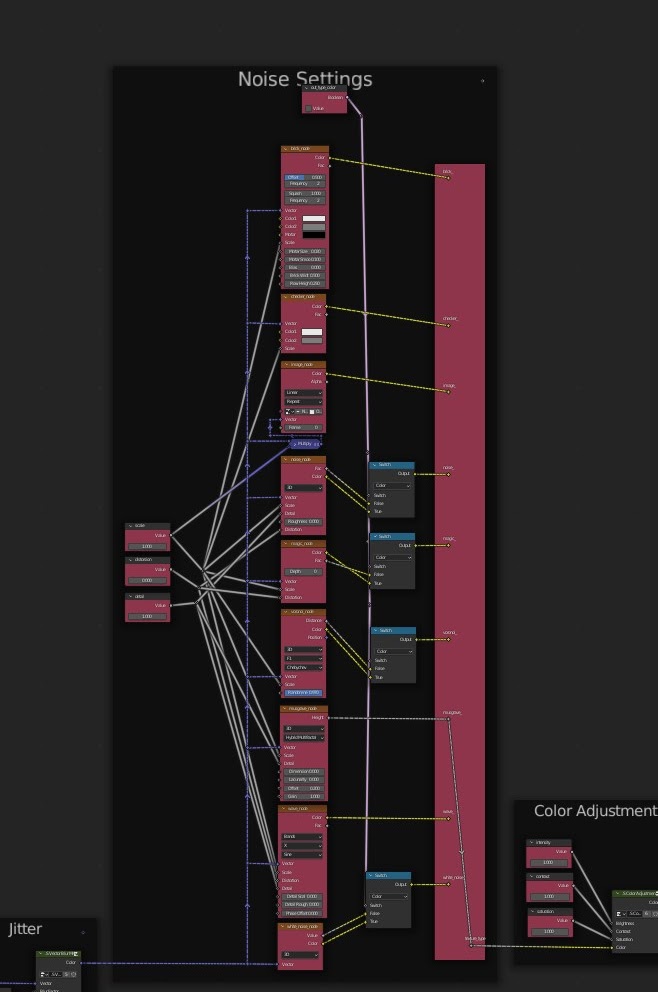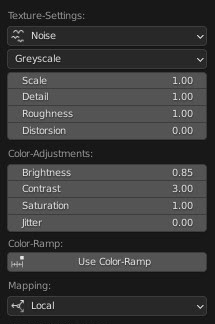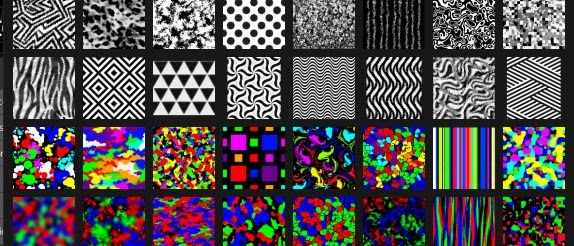Pattern Feature
One of the most powerful features of Geo-Scatter

Texture-Data Block
You might remember the texture-data properties from Blender 2.93? Well, unfortunately, this useful native feature will slowly become obsolete in later Blender versions.
For this reason, we decided to re-create our own "texture data block" within geometry nodes. In short, a "Scatter-Texture" data is a nodegroup set-up that will output a texture field.

Texture Settings
You can access texture-data settings by clicking on the properties icon.
Will be listed in this menu:
- The generic procedural noise types and their inherited properties
- The color adjustment settings
- The color-ramps widget, useful to create a color-based texture from black/white data!
- The projection settings, and mapping transforms matrix.

Image Libraries
An image library will be available If you choose an "Image" texture type. This library contains various greyscale, RGB, colorID, or flowmap images.
There are convenient "next/ previous" random operators available to quickly iterate over designs (demonstrated few gifs below).
Jittering
In the color-adjustments settings, there is a "Jitter" slider available, this property is very useful to generate a noisy transition in your colors, which will result in a more randomized influence on your scatter.
Above your "Scatter Object(s)" button you're able to choose if you will scatter the selection from the viewport, or from the asset browser.
Roll the dice
Under the transform values, there is a newly added "randomized transform" option.
If the mapping of your texture is not important, we advise activating this option as the master seed feature will be able to also influence your textures that way.
Visualization
It can be difficult to guess the texture by only looking at its effects on scatter-system(s), that's why we created the "Visualize" operator.
This operator will visualize the color attributes in the viewport while temporarily adding a visualization modifier on your surface(s).
Important
Because the texture is visualized in color attribute, the quality of the visualization will vary depending on your surface vertex disparity.
Patterns Slots
You have up to 3 pattern slots at your disposition
Influencing Scale/Density
If you need your scatter's density or scale to be affected by a procedural or image-based texture, the 'Pattern' feature is here for this very purpose. Three pattern slots will be at your disposal for creating either very natural or completely man-made-looking distribution looks.
Reminder
If you only want to use a simple noise texture on your instances scale, consider using the shrink feature in combination with a noise universal feature mask.
Multi-Users Texture
A scatter texture-data can be used in multiple scatter-systems at the same time. This is extremely useful to avoid collision between the various instances areas as you can assign scatter-system(s) to a color sample such as R/G/B channels, or a chosen ID color. If you'd like to make a texture unique, press the button displaying the number of users.
Presets/Biomes Support
When creating a new multi-layered biome, there is a toggle available during the biome creation process, used to define if the used presets will create a new texture-data, or re-uses an existing one if found. This is a key option to enable in order to create green-walls or decorative flower-mats biomes, for example.
Troubleshooting
By default Image textures are projected from the +Z axis, if you are using an "Image" texture-type, you will either need to rotate your mapping space by 90 degrees, or use a UV projection space.